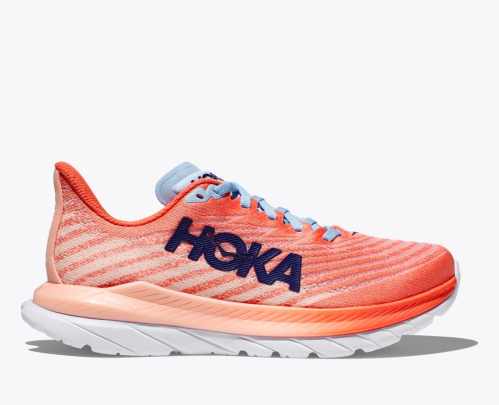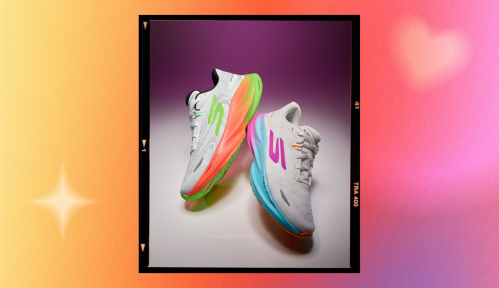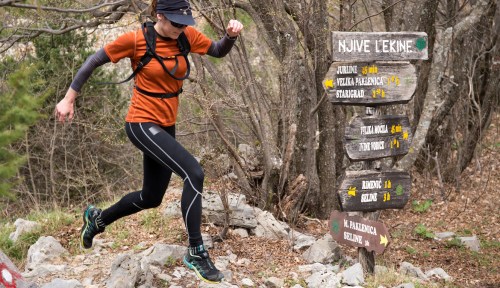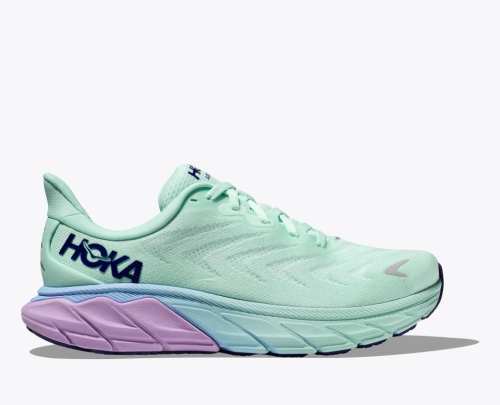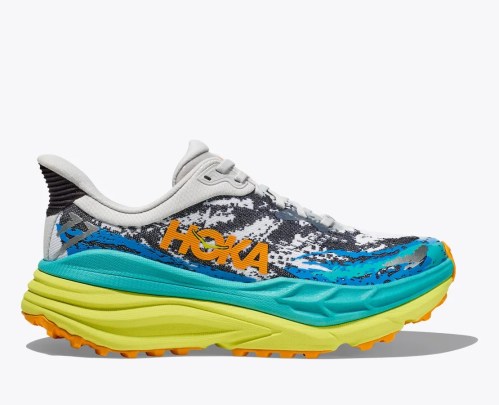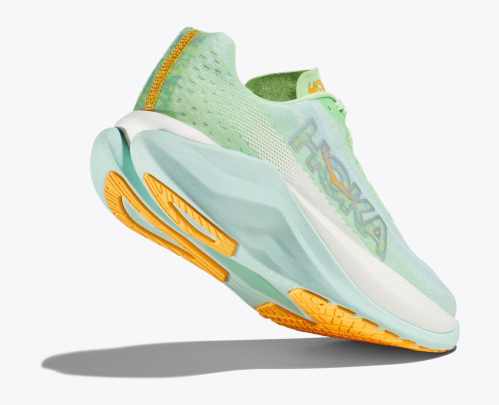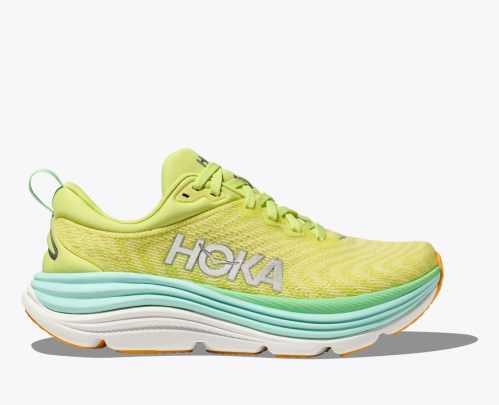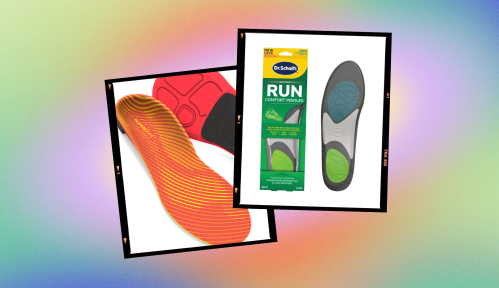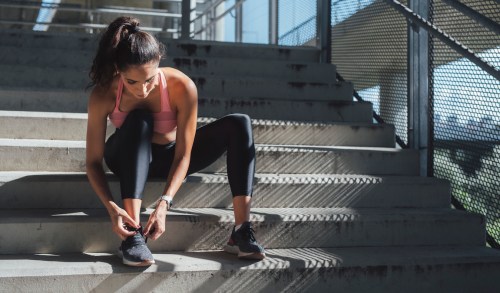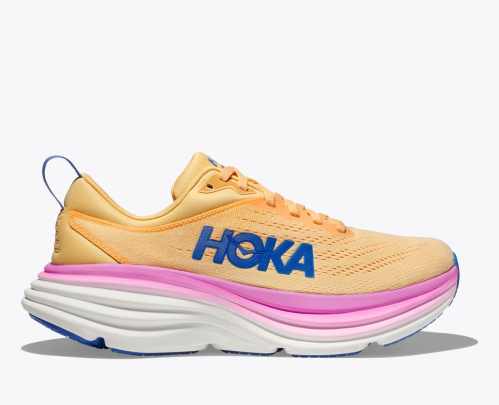Our editors independently select these products. Making a purchase through our links may earn Well+Good a commission
The 8 Best Hoka Shoes for Running, According to a Professional Long-Distance Runner
Diné runner Brandon Dugi shares the best Hoka shoes for running, be it speed training, long-distance racing, or casual, after-work jogs.

Runners care about running shoes. But distance runners really care about running shoes. That’s one reason why marathon runners love Hoka sneakers. To get the DL on this beloved brand, we tapped experts for tips and advice on the best Hoka shoes for running. We talked to a competitive long-distance runner, a marathon star, and an endurance trainer who shared their picks for everything from the best shoes for speed work to the best Hoka shoes for running for flat feet. Whether you’re prepping for a marathon or simply like to go on long runs, read on for the best Hoka running shoes for women.
Experts in This Article
professional runner and 10-time NCAA All-American athlete
a competitive long-distance trail runner based in LeChee, Arizona, a small community in the Navajo nation
a veteran endurance athlete based in Cleveland, Ohio. She is a Level 1 USA Triathlon coach and Level 3 USA Cycling coach. She is also an endurance coach at Life Time, an athletic club.
Best Hoka running shoes, at a glance:
- Best for short races: Mach 5 — $140.00
- Best for speed work: Rocket X 2 — $250.00
- Best for everyday jogs: Clifton 9 — $145.00
- Best support: Arahi 6 — $140.00
- Best for all-terrain: Stinson 7–$170.00
- Best for flat feet: Gaviota 5–$175
- Best for injury prevention: Bondi 8–$165
- Best training: Mach X–$180.00
If you’re not yet familiar with Hoka’s cloud-like sneakers, here is what you need to know. In 2009, two French adventure enthusiasts wanted a little more oomph in their running shoes, particularly when running downhill. They designed a sneaker with an overstuffed outsole with more cushion than other kicks on the market that could propel them forward with every stride. And thus, Hoka was born.
Since then, Hoka has ballooned in popularity, claiming space in closets for its out-of-this-world comfort that’s made them a popular option for walks and soft hikes. But, true to the brand’s roots, runners swear by them, too. Just ask Diné athlete Brandon Dugi, a competitive long-distance trail runner based in LeChee, Arizona, a small community in the Navajo nation. When he’s not shooting adventure photography, Dugi competes in Ultra races (defined as a run over 26.2 miles, and includes 50k and 100k) around the southwest and coaches his local high school’s cross-country team—all the while outfitted in Hoka sneakers and gear.
The good thing about Hoka is whatever shoe you choose gives you guaranteed comfort,” Dugi says. Still, some Hoka styles suit particular running styles and terrain better than others. Below are professional recommendations for Hoka running shoes for every training style and occasion.
What makes Hoka shoes good for running
There’s a myriad of features to love about Hoka for running, but Dugi points out the gusseted tongue of each shoe, which helps his feet feel secure during fast and long runs. Additionally, “when it comes to being on your feet for a long period of time, Hoka shoes come in clutch with the amount of good quality cushion that’s in each shoe,” he says. “Last but not least, the meta-rocker sole moves you forward with every step you take from heel to toe, providing you with a smooth ride [that] makes every run that much more comfortable.”
Whether you’re new to running or buying Hokas for the first time, Dugi recommends trying out a bunch of different Hoka styles to see which pair works well for you. But depending on your running goals and training preferences, the recommendations below are a good place to start.
Are Hokas good for distance running?
“Hokas are the perfect shoe for distance running because of the amount of support and cushion each shoe has,” Dugi says. “When the runs get long and you are on your feet for a longer period of time you want a shoe that is comfortable. Hokas deliver with the EVA midsole foam that keeps feet happy.”
Hoka’s are well-known for their curved cushioned, lightweight foam soles, which help to propel the foot and reduce the impact between the foot and the ground.
Stacy Rhea, an endurance coach at Life Time, an athletic club, also notes that Hokas are good for distance running because the shoes “propel the foot and reduce the impact between the foot and the ground.”
Before you decide which Hoka shoe is best for your distance running routine, make sure to look at the TechSpecs and examine the stability and cushion factors. Consider the terrain and your foot shape before selecting a pair.
Do marathon runners wear Hokas?
Yes, marathon runners do wear Hoka shoes. Dugi knows quite a few marathoners who train and race in the shoe: Stephanie Bruce, Ben Bruce, Aliphine Tuliamuk, Nick Hauger, Futsum Zienasellassie, and Matt Baxter who come to the top of his mind.
Hoka also provides a full roster of athletes who wear their shoes, as well as the races they’ve run and the specific shoe styles. These are broken down into different categories: Trail, Triathlon, and Road & Track. Female marathoners who run in Hokas include Alice Wright, Giovanna Epis, Kellyn Taylor, Matea Parlov Kostro, Paige Wood, and Steph Twell.
Best for short races
Mach 5 — $140.00
Sizes available: 5-11, in half sizes
From long-distance marathons to 5K races, there’s no better shoe than Hoka’s Mach 5, which happens to be Dugi’s everyday trainer. “This shoe is light and super comfortable with the right amount of cushion and breathability for those daily miles,” says Dugi. The midsole is lined with foam cushioning that soaks up the shock from daily impact, and the cushioned heel collar prevents irritation on long runs. Another feature worth talking about is the meta-rocker, making it easy to transition during strides. The Mach 5 offers neutral stability thanks to symmetrical cushioning. Lightweight, breathable, and supportive, the Mach 5s await to pound the pavement. It also comes with a partially recycled polyester mesh upper and recycled material laces.
Weight: 6.8oz
Heel-to-toe drop: 5mm
Colors: 12
Pros
- Lightweight
- Breathable
- Cushioned for everyday training
- Recycled materials
Cons
- Not available in wide widths
Best for speed work
Rocket X 2 — $250.00
Sizes available: 6-15, in half sizes
This is pro runner Alice Wright’s favorite Hoka shoe. “They have really good push-off, the foam feels incredible and produces a really good bounce,” she says. “All in all, they make me feel fast on the days I need it!” Dugi also swears that the Rocket X 2 ups the ante on speed work training. “It’s by far my favorite speed shoe I’ve ever put on my feet,” he says.
These sneakers feature a carbon fiber plate combined with plush PEBA foam to give them a responsive bounce that propels you forward with each step, he says. The sole is high-tech as it includes a propulsive carbon fiber plate that’s placed between two layers of high-performance foam. The bed cushion is geared for efficient-push off. The Rocket X 2 is geared for serious runners that need a glove-like fit. It has foot-hugging synthetic mesh and a gusseted tongue. It’s basically like an embrace for your feet. The cushioned sole means you also get superior protection and shock absorption for those high-impact sprints.
Weight: 8.3oz
Heel-to-toe drop: 5mm
Colors: 2
Pros
- Great for speed work
- Foam cushioning
- Gusseted tongue
- Shoe fits like a glove
Cons
- Expensive
- Limited colors
Best for everyday jogs
Clifton 9 — $145.00
Sizes available: 5-12, in half sizes and two widths
It goes without saying, but the Clifton 9s are the heroes of Hoka. Rhea, who is on her feet eight hours a day, is used to sore feet–but not if she wears these sneakers. “My feet instantly felt as though they were walking on a cloud. In other words, the cushion and support felt amazing! My foot issue has almost vanished due to the cushion and support from the Clifton 9.” These kicks are the epitome of versatility; they marry cushion, breathability, and flexibility, making them ideal for walks, runs, and soft hikes. The shoe can vent hot air thanks to the knit upper and boasts a gusseted tongue for a more secure fit. Also nice? “The balance between plush and responsiveness this shoe has is amazing,” says Dugi. That’s why Dugi wears this shoe for everything.
Weight: 7.3oz
Heel-to-toe drop: 5mm
Colors: 15
Read the full Hoka Clifton 9 review here.
Pros
- Lightweight
- Cushioned midsole good for balance
- Has gusseted tongue
- Available in two widths
Cons
- May not provide as much stability on uneven terrain
Best support
Arahi 6 — $140.00
Sizes available: 5-12, in half sizes and wide widths
Support is what you seek? Dugi’s recommendation is to go with the Arahi 6. “This shoe provides so much stability throughout the foot with its J-frame technology,” he says. The technology is designed to prevent your foot from rolling inwards, aka overpronation, making it a great Hoka option for flat feet. What also creates extra stability is the intentionally placed rubber on the sole, which offers increased traction on all types of surfaces. All of these features work in tandem to prevent injury, support you during long runs, and keep you moving and grooving pain-free. Ready to hit the road?
Weight: 7.6oz
Heel-to-toe drop: 5mm
Colors: 14
Pros
- Offers stability
- Minimizes overpronation
- Meta-rocker
Cons
- May feel snug for some
- Not available in wide
Best All-Terrain
Stinson 7 — $170.00
Sizes available: 5-11, in half sizes
While this is one of Hoka’s heavier shoes, it works hard. Dugi loves these shoes because they are really good for both on and off trails as well as roads, in part because of Stinson’s plush sole that still has grippy traction. You’ll also love the protective rubber toe cap can handle everything from roots to gravel. The shoe is stable because of the H-frame sole layer as well as an insole that keeps you from having a pronounced inward roll or overpronation. It also earned the American Podiatric Medical Association (APMA) Seal of Acceptance for its foot health benefits. One reviewer, who has been buying Hoka shoes for a decade, wrote that this shoe “felt so good and looked so beautiful. I would give them six stars if I could.”
Weight: 10.8 oz
Heel-to-toe drop: 5mm
Colors: 2
Pros:
- Improved traction
- Stable
- Plush sole
- Fun design
Cons:
- Limited colors
Best for training
Mach X — $180.00
Sizes available: 5-11, in half sizes
“In terms of training, the Mach X is a neutral, lightweight racing show and great for speed work,” Rhea says. The new model is a cross between the Mach and a propulsive high-rebound PEBA foam cushion that’s even more resilient than the Carbon X3 foam. This means it’s a shoe that works as hard as you do. You can wear these during high-endurance training sessions or if you just need to step up the pace. The toe box is roomy but not too wide, allowing you for comfortable lift-off. Thanks to the gusseted upper construction, your feet feel secure no matter what you do–from running stadiums to getting your miles on a treadmill. The 100 percent recycled material creel jacquard upper is breathable, yet sturdy.
Wright is loving the Mach X for moderate workouts. “They have a plastic plate, which is less aggressive than the carbon plate but gives the same ‘push off’ feeling which I love for long runs,” she adds.
Weight: 8 oz
Heel-to-toe drop: 5mm
Colors: 4
- Recycled materials
- Secure fit
- Comfortable toe box
- Breathable
Cons:
- Expensive
- Not available in wide
- Limited colors
Best for Flat Feet
Gaviota 5 — $165.00
Sizes available: 5-12, in half sizes and wide widths
In terms of training, Rhea says, the Gaviota 5 is a stability shoe with great cushion and best for long distances such as marathons and ultra distances. This style actually has a higher bed of cushion than other Hoka shoes, making it extremely forgiving when it comes to impact. We tested it both on pavement and gym strength-training workouts–and the cushy EVA foam and H-frame stabilizing technology certainly live up to its potential. Even the collar is incredibly soft, providing your feet with 360 degrees of comfort. No wonder the Gaviota 5 also earns the American Podiatric Medical Association (APMA) Seal of Acceptance. You’ll find that the toe box is also wider, allowing toes to splay as needed–though if you do have a very narrow foot, this shoe may feel a bit too spacious.
Weight: 9.1 oz
Heel-to-toe drop: 6mm
Colors: 5 in regular, 3 in wide
Pros:
- Extra roomy
- Very stable
- Extremely cushioned
Cons:
- May be too wide for some
- Can look a bit bulky
Best for Injury Prevention
Bondi 8 — $165.00
Sizes available: 5-12, in half sizes and wide widths
Cushioning is the name of the game for this Hoka shoe. Wright notes that the Bondi will always be her favorite choice for easy days. This shoe just has so much support and feels so cushiony,” she says. “Very injury preventative, in my opinion.” It has an Ortholite hybrid sockliner, extended heel for a better strike, and upgraded foam than previous models.
Weight: 8.9 oz
Heel-to-toe drop: 4mm
Colors: 20
Pros:
- Recycled materials
- Vegan
- Zonal weight placement
Sign up for the Well+Good SHOP Newsletter
Get exclusive deals on wellness, beauty, fitness, and food products that have been hand-picked by our editors.
Got it, you've been added to our email list.
